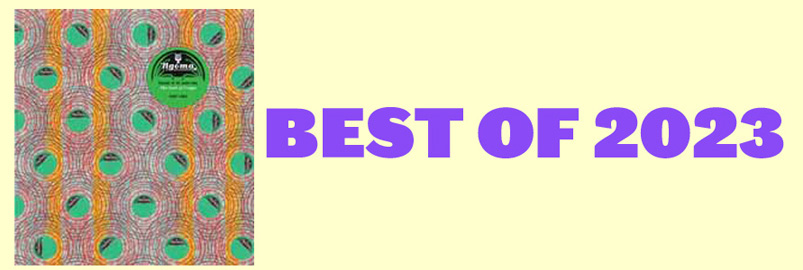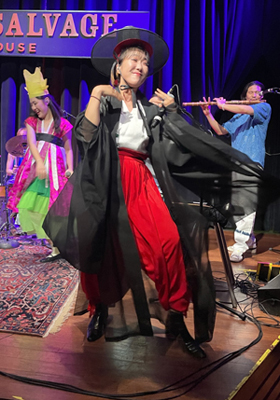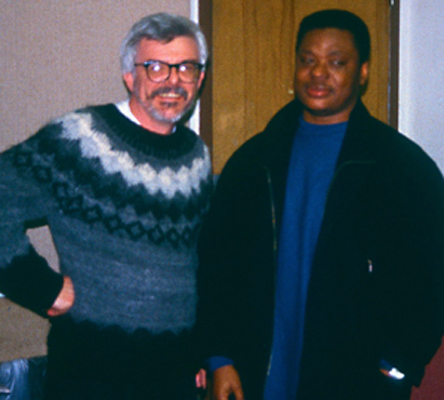Top Releases of 2023
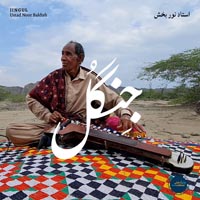
|
USTAD NOOR BAKHSH
JINGUL (Honiunhoni; available via Hive Mind)
When I first saw the video promoting this album I was electrified. Yes, it is traditional music from Balochistan and you may think I was under the influence of chemical forces, but the presentation and performance of the music was so exciting I couldn't stop watching it, over and over. I had no idea where Balochistan is; it looks like Rajasthan, dry and hot, but apparently it is coastal and a "Jingul" is a type of bird whose song inspired the performer. It's unlikely we in the West can go there to experience this first hand, now that I learn Noor's village is in a strip of land between Afghanistan, Pakistan and Iran. These are countries I would like to visit, but not in this lifetime (though I came close in Jodhpur 20 years ago). Their folk music is about migration and sea travel to Africa, Arabia and Persia. But here's the big kicker: the main instrument, played by Noor, is a toy! Called a Taishogoto, it was created for Japanese children, so one assumes it is conceived and constructed along the lines of a koto. Noor found one in a market in Karachi in the 90s, added a pickup, and now it is an electric Benju. Yes, that sounds like banjo as pronounced by Ed Sullivan... "Now, from Blotchystan, playing the electric benjou, let's give a warm welcome to Noor Baksheesh!" All kidding aside, this guy is not called Ustad, or Master, for nothing: he is a master of this former toy. His benju seems to have keys for stopping frets and sympathetic resonating strings, not to mention an amp to boost the sound. He has two tambour (Damboora) musicians backing him up. Anyone who can remind me of Hans Reichel and J. S. Bach at the same time has my highest respect. For a change the vinyl has more tracks than the digital release: there are 5 downloadable on bandcamp, 11 on the album. The whole thing was done live, one evening sitting by the river, as the sun went down, and the magical hour lives up to expectations. |
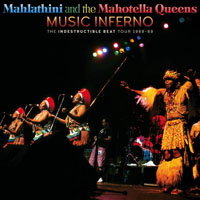 |
MAHLATHINI AND THE MAHOTELLA QUEENS
MUSIC INFERNO: THE INDESTRUCTIBLE BEAT TOUR 1988-89 (Umsakazo Records)
The "Indestructible Beat of Soweto" was the name given to a series of groundbreaking albums issued by Earthworks (London) in the mid-1980s, compiled by a couple of South African expatriates, Jumbo Vanrenan and Trevor Herman. From these compilations emerged some stellar names, Soul Brothers, Abafana Baseqhudeni, Moses Mchunu, Ladysmith Black Mambazo, and of course Mahlathini and the Mahotella Queens, who soon had their own albums reissued in England. Malcolm McLaren and Paul Simon took note, as did the rest of the hip music audience and when the, admittedly now aging, M&M Queens came on a world tour in 1988 we were all ready to jive. I had the pleasure of meeting them in person but also the absolute thrill of seeing them perform with the hardest working band in show business, who at the time were the Makgona Tshole Band, comprised of Joseph Makwela (bass), Philemon Hamole (drums), Marks Mankwane (lead guitar), Sipho Madondo (rhythm), with West Nkosi on sax and pennywhistle. David Mzwandile also joined the tour on keyboards and accordion. This band were the inventors of mbaqanga, the hard-driving sound of South Africa's townships through the sixtes and seventies. When they toured they could draw on innumerable hits, such as "Thokozile," "Jive Makgona," "Melodi ya lla," and "Kazet" which they performed with even more energy than on the albums, belying their 30 years on stage. Only James Brown maintained that level of intensity into his older years. This was their key: as dynamic as they were on record, they were astonishing to behold live. The Queens in their grass skirts bounded onto the stage followed by the skinny "Lion of Soweto," the deep growling Simon Mahlathini. When the spirit grabbed him he would also leap into traditional Zulu dance moves as the band pounded away with their breakbeat tempo. Their tours were legendary and now a fan, who travelled with them as a photographer and preserved the board tapes from their English shows, has creamed the crop to create the sequence of a real show (including a break for the Queens in the middle with Nkosi performing his own hit "Stokfel Jive"). In addition to the 16 tracks on the LP or CD, there is a startling digital gift for downloaders of two bonus tracks and two sound checks from Ronnie Scott's. These latter are really amazing: both made on June 12, 1988 and showing the band merely warming up, trying out the sound system, but it is spontaneous jamming and finally when Simon comes in singing they get something like a tune together but are essentially just grooving for their own amusement. As Mahlathini was fond of saying, "It's nice, nice!" and as the Queens invariably replied, "Yebo!" |
 |
I heard the first single off this album 6 years ago, so it has been a long-term project, and Dogo has put a lot of energy into making this a beautiful album of gentle acoustic guitar ballads with traditional melodies, rhythms and percussive backing. As it is a small country squeezed between Ghana, Benin, and Burkina Faso, Togo has a lot of music that is familiar from those neighboring countries too, whether they are Ewe or Kabye people making the music. One regional artist that Dogo's music brings to mind is Gnonnas Pedro. And of course other influences crept in, from James Brown in the 60s, to Highlife in the 70s, and Soukous in the 80s. Recorded in Lomé, Togo, Dogo brought together local musicians, including his own teacher to play lead guitar. This man, Serge Kodjovi, also know as Oya Yao has played in rock bands, jazz bands and of course understands the traditional guitar patterns also, whether pentatonic or otherwise. But the group of musicians are equally talented, in fact most of them are soloists in their own right, or in other working bands too. Part of Dogo's sophistication comes from his global perspective. He now lives in the USA after coming here to study, but discovers, while he is a foreigner here, he is also a stranger in his homeland when he returns. I know how he feels. This gives you a keen perspective on both places however. There's an interview with Dogo on Afropop, if you want to learn more. |
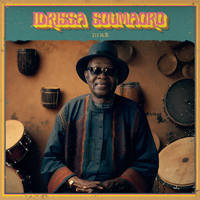
|
IDRISSA SOUMAORO
DIRE (Mieruba)
Idrissa Soumaoro's Diré hearkens back to the classic age of Malian guitar-slingers in the mould of Ali Farka Touré. Diré is the destination of the album, the place where Soumaoro met his wife and settled for a while. Back in the 1970s this was a lovely peaceful spot, he recalls, and of course he doesn't need to remind us of the now-dire straits the country is in. His repertoire comes from the hunter's clan, and he also plays the traditional donso n'goni, associated with those Bambara musicians. Over his long life he has also absorbed influences from every other kind of music he has come into contact with, including rumba, salsa, country, R&B, but in addition to the guitar we hear flute and balafon which ground us in the arid desert of the Sahel and the uniquely West African blues sound. Growing up he borrowed a guitar and tuned it to the sound of the n'goni, as he understood the pentatonic scale better. In his teens he appeared on television, performing his own composition "Ancien Combattant," which became a big hit when covered by Zao, a Congolese singer. But Soumaoro kept his day job, teaching, sometimes gigging at night with les Ambassadeurs du Motel alongside Salif Keïta and Kanté Manfila. He also met Amadou Bakayoko, the blind guitarist, and relocated to the Institute for the Blind in Bamako to teach there and help raise awareness of the needs of the blind community. There he started a group called Eclipse, including some of his blind students. His own solo career did not begin until 20 years ago, in his 50s; he created another hit when a song he performed with Ali Farka Touré was featured in the film Black Panther. But now Soumaoro gets the full spotlight to showcase his bluesy guitar and smooth vocals, with support from Yao Dembele on bass and organ, Yvo Adadi on drums and percussion, Cheick Diallo on flute, Bouramani Kouyate on second guitar, plus balafon (on "Don't worry," sung in English) and n'goni, played by Mohamadou Dramé. His n'goni playing is outstanding on "N'den tedi." The albums ends with "Yele," which I think is a cover of an Ambassadeurs song; Amadou Bakayoko makes a guest appearance on this track. |
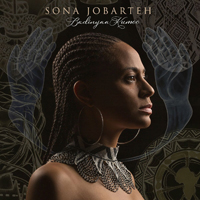 |
SONA JOBARTEH
BADINYAA KUMOO (Self-published)
Sona Jobareteh is the first female griot, a traditional singer from the Gambia who accompanies herself on the kora. Now based in Britain she still runs an academy in her homeland while making a mark on the international stage. Her goal is to use her role as a traditional griot to educate and inform contemporary life through music. This is actually a 2022 release, and she has another 2023 album that I have not heard yet. The music is pleasant, in the vein of traditional mellow griot music you would expect, veering towards easy listening on tracks like "Nna mooya," with sleepy sax and a lullaby chorus. The third track, "Kambengwo," has a guest vocal by Youssou Ndour. This builds to a fiery assault. "Ballaké Sissoko" is a tribute to that musician with lots of plangent plinking on the kora. "Gambia," also leaps out at you when djembe drums take over, and that burst of energy is what the disc needs. Sona sings, plays guitar, kora and bass on this so she is not short of talent. But then we go back to dreamtime, with "Nna kagwo" which has pleasant acoustic guitar and a wailing blues harmonica. This is a fine disc, which may be damning it with faint praise, but after Youssou's appearance, everything else seems a bit anticlimactic. If they'd saved Youssou until last it would've made a fine capper. |
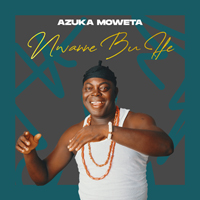 |
AZUKA MOWETA & HIS ANIOMA BROTHERS
NWANNE BU IFE (Palenque Records)
There's Delta Blues, from Mississippi, and then there's Delta Highlife, from Asaba, which is in Delta State, Nigeria. It's at one remove from Igbo highlife adding something Palenque Records boss Lucas Silva tells us is Ekobe music, which brings a long gong (Ogene), maracas (Ichaka), pot (Udu) and other drums (Igba) to the percussion backing. The chorus is chanted and the arrangement is frenetic guitars and trap drums too. Anioma means "Good land" in Igbo, and their location is deep in the Delta towards Benin City. Though it's new it does sound like traditional Highlife to me. The old whingey organ does make it sound like a 70s album, but I guess it's a retro touch, as this is a new recording. The guitar is sweet and the lead vocal by Moweta is assured, as the percussion keeps the whole thing moving along. They are typical seven or eight-minute tracks, with the opener stretching out to over 16 minutes. The final cut, "Ahaba Sound System," is solely percussive, which really works out, with the two guitars twisting around on top. |
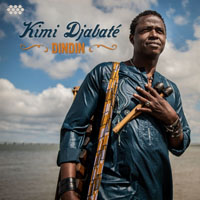 |
KIMI DJABATE
DINDIN (Cumbancha)
A very polished album, this is the fourth outing from Kimi Djabaté. Many generations ago, his ancestors from Mali went to Guinea-Bissau to perform at court, were invited to stay in Tabato and they turned the area into a cultural center for music, dance, arts and crafts. To me, Dindin is a childhood expression for dinner, and curiously the title track is about hungry children. Don't exploit them, educate them, but leave them time for playing games, he enjoins. He himself was forced into a musical career, against his will, and made to practice balafon rather than study schoolwork, and often went hungry. At 8 he was sent to another village to study kora. He was a child performer, but took no joy in it. At 19 he joined the national dance troupe and jumped ship in Lisbon, deciding to settle there, rather than return home. He has been in Portugal for 30 years now, broadening his musical horizons. Justice and hope are his main themes. The ballad, "Ná (Mother)," reminds me of Touré Kunda, and once I made that connection (specifically to the album Casamance au Clair de Lune), I began to feel strong parallels with those other griots. The album is generally contemplative. There are sweet touches of balafon and then we hear electric guitar and surprisingly Paolo Borges, an accordionist, joins in. Kimi was featured on Madonna's latest hit "Ciao Bella" but fortunately he did not invite her to reciprocate. "Afonhe" has Borges playing a reggae organ riff, with pumped up horns. "Alidonike" features wild Toureg-style lead guitar and more of a Malian rock groove with balafon continuo. I presume Djabaté is multi-tracked on this one. Overall, this is an accomplished and mellow album. |
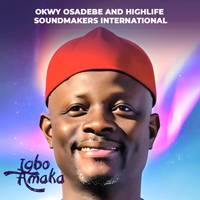 |
OKWY OSADEBE AND HIGHLIFE SOUNDMAKERS INTERNATIONAL
IGBO AMAKA (Palenque Records)
Chief Stephen Osita Osadebe (this artist's father) was one of the most influential Highlife stars of the golden age. Though less well-known than Sunny Ade, Ebenezer Obey or others, he made steady inroads in the west until his reputation was firmly established among connoisseurs and collectors of Nigerian music. According to discogs, he put out 50 long-playing albums. These came out mainly on the Polydor label from the mid-70s to the mid-80s. I never regretted grabbing every one I came across until I had about 20 (I do regret getting rid of them in my big vinyl purge in 2002 which financed some travel). Towards the end of his career, in 1996, he released "Kedu America," a beautifully recorded CD on Green Linnet that recaptured a lot of his hits in abridged form. Chief Stephen's eldest son Okwy has assumed the mantle and taken over the helm of the great band that Chief Stephen fronted so successfully for three decades. I dwell on the relationship because Okwuchukwu, or Okwy, sounds a lot like his father and, in addition to the continuity of the entrancing Igbo vocals, there is of course the dependable group of musicians which continues in the same mellow mode we have come to love. This includes muted trumpet, a warm murmur of guitars along with off-kilter drumming; little sportive bursts on traps in counterpoint to solid congas and a sweet susurration of smaller percussion. As the vocals glide in and out, the wiry guitar with wah wah steps up for a chorus, answered by the trumpets. It is perfect. And apparently in concert the son has a lot of youthful swagger and enough of the "Cool Ruler" to bring the sophisticated sound to an even larger audience, as witnessed by the fact this release is on the culturally diverse Palenque label based in Bogotá! |
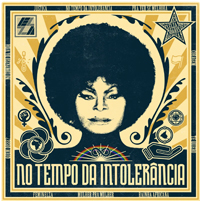 |
ELZA SOARES
NO TEMPO DA INTOLERANCIA (Deckdisc)
Elza Soares was working on this album "In the Time of Intolerance" at the time of her death in January 2022 at the age of 92. She had enjoyed a late-career revival and in this final round-up sings material sent to her or co-written by Ivone Lara, Rita Lee and Roberto de Carvalho, and other, mainly women, Brazilian composers. Josyara from Bahia helped finish up the work. After Elza sent her some lyrics she agreed to collaborate, adding guitar and writing the brass arrangements. The production is a bit more lush, with overdubbed strings, and less hard-edge funk rock than on her come-back albums, The Woman at the End of the World (2015) and God is a Woman (2018), though her voice is as brittle as ever. In her seven-decade career she covered all the styles from early Carioca sambas to the wild punk screaming that announced her return at 85. She became a voice for the oppressed, speaking out against racism, social inequality and violence against women. Towards the end of her life Brazilian society was in retrograde with Bolsonaro, the "tropical Trump" acting like a pig, allowing cronies to burn the Amazon, denying there was a pandemic, attacking gays, etc. There is a strong feminist message in her lyrics, and those she drew from her collaborators for this final outing. Her words include this: "They say I'm controversial/ As Luther King used to say/ If you want an enemy/ Just say what you think." |
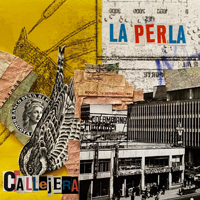 |
The three ladies who comprise the band La Perla, Diana Sanmiguel, Karen Forero and Giovanna Mogollón, hail from Bogotá, Colombia. They have been performing for 8 years and this is their second album. It's a beautiful production: they move from deep rootsy conga drumming with cowbell to rap with tasty studio effects. "Palalma," which starts as rap, resolves in heavenly harmonies. The power of their drumming invokes dense jungles, while "tropical" sound effects add an air of mystical Amazonian landscapes. Brazil, Peru and Ecuador are invoked musically on "Florion." At first "Ojos brillantes (Bright eyes)" sounds like Cuban rumba but it is actually Bullerengue. Samba is served up on "Selva (Jungle)," which was their debut release in October 2021. They contrast the lush landscape with the grey cement of cities like Bogotá on "Tabogo," which they describe as punk merengue. With strong roots in traditional music La Perla have created an assured well-rounded set.
|
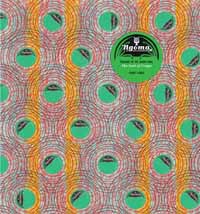 |
NGOMA: THE SOUL OF CONGO
(3 CD or 3 LP set from Planet Ilunga PI 10)
This is from the press release, written by me. I also compiled and annotated the collection:
Ngoma: the Soul of Congo is a compilation that spans the years from 1948 to 1963 as the Belgian Congo emerged from colonial subjugation into the first flower of Independence. Singers and players came to Congo's capital Léopoldville, from all over Central Africa — from the busy streets of Brazzaville on the opposite shore of the Congo river to the vast plateau of Mbanza Congo in Angola, from the mineral rich areas of Lubumbashi (Elizabethville) in the Deep South to the lively docks of Kisangani (Stanleyville) in the northeast, from the rocky wastes of Mbandaka (Coquilhatville) in the West to the majestic forests of Bukavu (Costermansville) in the East. Léopoldville became a cauldron of musical syncretism between the African rhythms that arrived with these musicians and the European, Caribbean and Cuban tunes that were popular in the big city. The new sounds were recorded for one of the big five Congo labels: Opika, Loningisa, Esengo, Olympia or Ngoma. Musicians sang their songs in many languages: Lingala, Kiswahili, Kikongo, Tshiluba, Lari and Budja. And to show their urbanity: Espangol, a fractured form of Spanish, heard here in half a dozen selections. And although their lyrics covered many topics such as love, daily life, and the quest for freedom, their main message had no language since it was a musical one: to spread joy and hope.
None of the other Congolese labels better showcased the energy, variety & spirit of this era than the Ngoma label. During its existence, from 1948 until 1971, Ngoma made over 4500 recordings, creating a crucial cultural legacy, recognized as long ago as 1954 when poet Philippe Soupault wrote on behalf of UNESCO to Nikis Cavvadias, owner of Ngoma, thanking him for his work "collecting popular melodies and traditional songs which have caught the attention of the whole world. You've contributed to enlarging the knowledge of humanity." As the Ngoma label flourished, so too did the first big stars of this new sound: Manuel d'Oliveira from San Salvador (who excelled in the polka piqué rhythm), Antoine Kolosoyi "Wendo'' from Bandundu and Léon Bukasa from Katanga. Cavvadias suggested they form a power trio, called Trio BOW and go on tour. He drove, and the tour lasted 20 months, reaching the borders of Angola and Cameroun. They crossed vast forests and rivers with help from locals who signaled their approach with tamtams or lokoles and then came out in the thousands to welcome the stars and fete them for their musical performances. The three of them are heavily featured in the Ngoma catalogue and in this compilation. They were all charismatic singers and guitarists who knew folk music but also adapted popular music from Cuba (heard on the famous GV records). Ngoma also provided a way for female singers, such as Martha Badibala, to rise to fame and inspire other women to dream of a life beyond taking care of the kids and husband. Ngoma still recorded traditional folkloric music, such as the songs by old-time accordionist Camille Feruzi and likembe player Antoine Mundanda, but also looked for fresh talent as far away as Brussels where they recorded Camerounian heartthrob Charles Lembe fronting a fierce quartet on some flashy adapted Cuban Guaracha rhythms. Instrumentalists like Antoine Kasongo (clarinet), Albino Kalombo (sax) and Tino Baroza (guitar) also made their mark through the Ngoma recordings.
Adou Elenga's 1954 hit "Ata Ndele," that criticized the white colonists, led to his imprisonment and the song being quickly deleted from the catalogue (long sought after, a rare copy has been found for this collection). Already in 1953 he suggested a "change was gonna come," and slowly but surely it did. Angolan Paul Mwanga, too, was unstinting in his criticism of the colonials, and he was also active with authors' rights associations. Frank Lassan was a singer who brought the romantic style of French crooners to Congolese popular culture, while guitar wizard Manoka De Saïo or "Maitre Colon Gentil" (Genteel Settler) were flamboyant popular figures in the nightclub scene, captured on disc. Guitar prodigies like Antoine Nedule "Papa Noel" or Mose Se Sengo "Fan Fan" cut their teeth as teenagers in studio bands (Maquina Loca and Jazz Babalou) which had fluid membership. The band names changed rapidly — Jazz Mango, Jazz Venus, Dynamic Jazz, Affeinta Jazz, Mysterieux Jazz, Rumbanella Bande, Beguen Band, Vedette Jazz, La Palma, Negrita Jazz — all of them are heard here. At first the word "jazz" was applied to the Cuban guïro or scraper, but as it came to indicate modern urbanity it was adapted for many band names.
Now sadly, the Ngoma legacy has been decimated as many of the original recordings were played to bits or otherwise lost to posterity. A step towards preservation of our knowledge of Ngoma was made when Flemming Harrev created a massive discography and history of the label on his afrodisc website. When he died in 2020 the compiler had the idea of assembling a memorial disc in tribute to Flemming Harrev. He stated that afrodisc.com was "a tribute to the creativity and diversity of the performers," and now we have the opportunity of hearing some of the music, beautifully restored.
Ngoma: the Soul of Congo is the 10th release since the creation of the Planet Ilunga label in 2013 and their most ambitious project to date. Tracklist of the 3 LP set is here; tracklist of the 3CD set is here
|
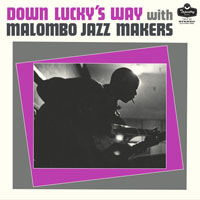 |
MALOMBO JAZZ MAKERS
DOWN LUCKY'S WAY (Tapestry Works TWLP02)
"It never rains but it pours" is true also of music discoveries. Just last month Strut announced they were reissuing the first two albums of South African group Malombo Jazz Makers from 1966. And now we have another, from Tapestry Works. Down Lucky's Way was their third album, from 1969. I have a great appreciation for Malombo thanks to Man Phily (1986), the compilation put out by Günter Gretz of Popular African Music, which was one of many gems he issued on vinyl from his base in Germany. That original Malombo featured Philip Tabane on guitar with a mellow jazz-influenced set of dreamy and hypnotic music. Tabane left and the group reformed as the Malombo Jazz Makers, now with Lucas "Lucky" Madumetja Ranku on guitar, still keeping Julian Bahula on percussion and Abbey Cindi on flute and soprano sax. Their name comes from the traditional malompo drums you hear on here, that are used in healing ceremonies. While the music is instrumental it was felt to be deeply political: using indigenous instruments to express themselves in apartheid South Africa. Gallo recorded the album but very few copies made it to market, either it was suppressed or deleted, because Malombo were known as trouble-stirrers. Music as a weapon! The titles are in Sotho, including "Matshenyogo," which means "The Struggle." As Bahula said, "the Boers were too stupid to learn our language so we could get away with titles like that." They toured clandestinely with Steve Biko, the student activist, and appeared on stage with white musicians, either wearing masks or painted with UV paint. Their concerts often ended when Special Branch officers appeared, tossing smoke bombs into the crowd. Then the police started looking for Bahula, showing up at his home demanding to know where he was. One thing they knew for sure was his drumming was getting to them. Finally Julian and Lucky were forced to flee to England in 1974 where they joined with Dudu Pukwana and even appeared on the Specials' hit "Free Nelson Mandela," singing chorus. But here, in their prime, we can appreciate their talents, stretching out in wonderful long jams. There is a continuity with the mellow, jazzy Tabane vibe which is what Cindi and Bahula wanted when they realized Tabane was too unreliable to tour and stick with them. For this disc they added bass and some discreet organ, which fills out the sound nicely. How mellow is it? "Tribute to A. Motjuoadi" is based on "Silent Night" which is about as laid back as you can get! |
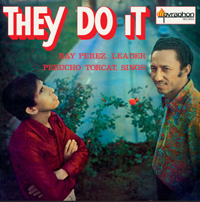 |
RAY PEREZ & PERUCHO TORCAT
THEY DO IT (VampiSoul 275)
There's no stopping Ray Pérez, Venezuelan pianist and bandleader. As we have recently learned, with the gradual reappearance of his back catalogue, he created a fun jam band called Los Dementes in 1965, then Los Kenya (1968), and then he formed Los Calvos, the "Baldies," before moving to the Big Apple in the late 60s. Inspired, he returned to Venezuela in 1971 and picked up where he left off. For me it's a like a chunk of legendary salsa band La Perfecta suddenly popped up. It is that sweet and rare a treat. This 1971 album came out under his own name, with singer Perucho Torcat (from Los Dementes), sounding like Hector Lavoe. It's salsa duro, which means watch out for trombones. There's some silly scat singing but mainly driving danceable salsa. At the time, 1971, salsa had just emerged in the Fania studios on discs by Hector Lavoe and Willie Colon that fused disparate Cuban styles: son, guaguanco, guaracha and guajira, into a hot sauce ("salsa") that would change Latin music forever, pushing on from tracks like Arsenio Rodriguez' "Fuego en el 23." And Perucho (a New Yorker, who died the following year) and Perez were able to capture the essence in their work. They mix it up here with a bolero and some boogaloo. There is a sound problem with the first track on side B, "Lengua e hacha," which I wished they had addressed. It sounds like it was recorded in a tin can, at least for the opening few bars: they must have been experimenting in the studio with some filter on the board: big mistake, but don't let that deter you. This one goes on repeat. There's lots of stop-start breaks to tease dancers too, as on the guaguanco "Lo que el abuelo cantaba (What grandpa sang)." Here, Perucho sings like Ismael Miranda. Alan Brain tells me it's inspired by "Abran Paso," released the same year by Miranda with Larry Harlow. The twin trombones blast hot air over cowbell and timbales and Pérez vamping madly on the keyboard. The riffs are great, like a lexicon of salsa with horn counterpoint driving the singer closer to the mike. When they bring it down the piano hangs in the air between ideas, and we hear the conguero and guiro, with the timbales player just ticking the time on the sides of his kit. "Muchacho loco (Crazy kid)" is in English but that still doesn't mean I know what he is singing about. There's a Ray Charles "Ain't that Peculiar"-sort of riff on the pianist's left hand, to set it off, but then everyone throws down with a fiendish heat that suggests they rehearsed to the point where Pérez could point at the horns and they would know when to drop in a fat chord.
|
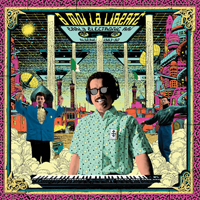 |
A MOI LA LIBERTE
EARLY ELECTRONIC RAI (ALGERIA 1983-90) (Born Bad Records)
Can we talk about synthesizers? I mean there's good, bad and ugly aspects to the instrument. When it was introduced in the late 70 it was a boon to musicians in third world countries: it was small and portable and heavy pianos or organs will not hold their tune in extreme humidity. So synths were picked up by Rai musicians in Algeria, as well as impoverished musicians in places like Haiti, who could no longer afford a big combo with many horn players and percussionists. As a rule however the early synths are as convincing as say a Melodica in replicating a genuine keyboard sound, whether it was emulating a bass guitar or a spindly guitar lead, or even a modest church harmonium. I once borrowed a Moog from Steve Fisk, who was my neighbor, for a gig with my band. I blarted away merrily with one hand on the two-octave keyboard while twiddling knobs with the other, colliding sine waves, during a "solo." The tune was a punk cover of the Partridge Family's "I think I love you." Fortunately the recording tape had run out. Once you get past the limitations of the sound though there is the problem of performance. It seems to me that most bands got a synth in the 80s, and decided it was fair game for anyone to play. There was nothing holding them back, they just were taken with the novelty of this squeaky loud toy (whether a Prophet 5 or a Yahama DX7, which could store sounds or work as a MIDI bridge between instruments) and pinged away relentlessly at the keys. The drum machines also had their limitations (especially those built-in to keyboards), the Roland TR-808 or its predecessor, the Boss DR3 "Doctor Rhythm," could give you the semblance of a handclap on the one, then little irritating thin claves and a snare fill every third beat. This gets tiresome fast, especially if you are used to the flexibility inherent in performance where the percussionists drive the band to alter the tempo. Now to get to the point, Rai musicians in Algeria made a virtue of the new cheap technology. They abandoned ouds and traditional drums and embraced synthesized keyboards and bass, simple rhythmic drum patterns that created a backing wall for singers to wail. The track by Houari Benchenet is a good example. We remember fondly Cheb Khaled, Cheb Mami and the others who emerged from the Red Light district of Oran, but now here is a well-sorted retrospective of the best of the rest of the genre, from artists that we missed back then. Cheb Hindi kicks off with the title cut and it is a gem, even though it does remind me of the first Khaled album that had us all nodding along. The title is in French; "Freedom for me" it says. The syn-drums plonk along relentlessly but the synth is creative and makes some plaintive background wails. There's even whistling. Looking back now there is an insouciant charm to the sound, loads of echo on everything: the drums, the voice, lots of little twiddly effects, maybe even some actual hand drums caught up in the wash of echo and wall of synth. But it's not all peaches and cream: "Khalouni" by Chab Mohamad Sghir has a truly wretched pair of synths vying for our attention — this one is nigh unlistenable (for me anyway). Cheb Tahar has a very farty bass synth which spoils his otherwise decent effort. Given that these instruments made original sounds, quite different from traditional ones, there is a lot of variety to explore, but overall the melodic qualities are lacking and we have to focus on the singers to find the pleasure in some of the songs. Cheb Kader, a name you might know, has actual percussion instruments and a decent sax player. This track called "Reggae Rai" is no more reggaefied than the others, but does stand out as well-produced. The next track "Zahri mate" by Cheb Hamouda has a reggae bass line and sporty trumpet, but the other instruments are not as well focussed. But Chaba Amel's call and response vocals on "Lala Kusti" is another standout. Thanks to Earthworks, back in the day, we had a small window into this music, and now this compilation reminds us how infectious it could be. |
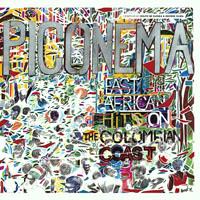 |
PICONEMA: EAST AFRICAN HITS ON THE COLOMBIAN COAST (Rocafort Records)
The picotera sound system DJs of Colombia are relentless. They search high and low for rare African 45s (I know because they have made me offers I couldn't refuse for duplicates or scratchy singles from my own collection). They go so far as to obliterate the labels (like Jamaica DJs in their sound system era) so no one can spy on them when they drop a particularly hot track. It doesn't matter when it was released: 1970s? No problem, as long as there is the "caida" — the moment when they get down to the bare bones, mi-solo guitar and the drums, and the dancers go nuts. The Colombians even perfected the "needle-drop return" to go back to the start of that part over and over like an extended mix stretching the song. (Frank Zappa once said he would put a dot of chalk on records where the hot part started so he could drop the needle right on it.) My passion for this music led to my Congo in Kenya page, because these were the bands that brought the cavacha sound I love from Congo to East Africa. All the tracks here have something to recommend them strongly, and it is surprising it has taken so long for someone to put together a compilation like this. Big thanks to George Ouma and Golfo De Guinea for doing this. There was my own Shika Shika compilation on No Wahala Sound, but they decided to go with a single LP and swapped out one of my selections, so it was not my vision finally. But no matter, I have loads more Shika Shika singles and they are all as good as the one on here, "Diabanza," (track 3) which is a stone jam. You also hear Moreno Batamba on harmony vocals and though there are 2CDs of his music from Stern's (that the late Doug Paterson compiled), there is a lot more great music out there by this under-rated singer.
Sometimes a compilation will come out and I can review it without buying it, like for example the Star Band de Dakar set of Latin tracks Psicodelia Afro-Cubana de Senegal. I looked in my music hard drive and had all the tracks on their original albums, so I could compile it myself, and review it, as the reissue made no attempt at remastering the sound. In the case of this album under review, much of the music is very familiar because I play it a lot. It also reaffirms the good taste of Colombian DJs who like the same East African bands that I do. The set starts gently with Tanzania's Maroon Commandos, singing "Sophia," from their 1982 album Usiniambie Unaenda (Don't Tell Me You're Going). Another mellow outing, Issa Juma's "Ateka," was on the Sigalame 2 LP which I am sure you own (It was reissued by Discafrique of Bristol in 1990). Things heat up for "Diabanza" by Moni Mambo Jim, which came out on the Bolingo label. The opening notes on bright lead guitar seem to suggest "Hit the dancefloor!" Only 90 seconds in, Lava Machine indicates it's time to up the tempo. Next up, the smoking "Safari" by Coco Jericho Zigo fronting Viva Makale first appeared on Editions Mwana Mama in Kenya and was reissued on 12 inch by the Makossa label in Brooklyn, USA in 1981. Both of these singers, like the guitarists, were frequently nzonzing on others' albums and so their is a continuity and fluidity to groups like Moja One, Viva Makale, Shika Shika and so on. "Safari" by Viva Makale has Lava Machine on the drums, Koko Zigo Mike where you'd expect — on the mike. The guitars were "Chery" Matumona (now in Canada), rhythmist Siama Matuzungidi (now in Minnesota), and Thomy Kabeya Lomboto on bass guitar (maybe in Bangui). The two guitarists later joined Shika Shika, with the drummer Lava Machine.
"Trouble" by Bwamy Walumona and Les Mangelepa (track 5) appeared on Conseil Gratuit (Free Advice), which was an mp3 release in 1982, but I don't know if it was official. It also came out as a single on their own label and on a Golden Hits comp on ASL. Their had originally come east with Baba Gaston before abandoning him and Baba National to start their own band in 1976. Their horns led by trombonist Kakai Badibanga are notable for their ferocity, but it's the mi-solo guitar and drums who get into trouble with a wild breakdown 8 minutes in. Nairobi Matata Jazz quote "Masanga" in their "Dada Mwajuma" (track 5; one I did not own!). I have their Polydor album but none of the three they self-published. This one is available for 120 euros on discogs if you want the original. Les Volcano's "Hakuna dawa ya mapenzi (There is no love potion)" came out on Bingwa. It was written by Charles Ray Kasembe, who took over after the death of Mbaraka Mwinshehe. I am glad to hear a clean copy. "Safi (Fresh)" by Lawi Somana is a Swahili ditty from the mid-7os which originally came out on SOA. It has pedal steel guitar on it, quite a novelty. It was also reissued on Makossa records in Brooklyn, in 1981. Lawi was sax player with Moja One and Shika Shika also. All of these tracks are nine minutes, so full length A and B sides, giving the musicians ample time to stretch out and explore the melody. We end with Les Kilimambogo Brothers and "Wakumbuke Wazazi (Remember the old folks)" which was collected on their Popular African Music LP Simba Africa. It's a distinct Kamba musical style, Guenter told us, with George Onyango on guitar (scratching with his plectrum behind the bridge to signal the breakdown) and Kakai Kilonzo, also on guitar. This one has all the great elements of a "caida" to die for, rescusitate, skip back and repeat.
|
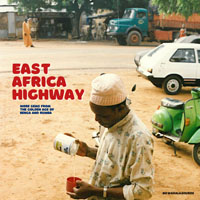 |
No Wahala return to the vaults of Audio Productions of Nairobi for some early 80s tunes, most of which have fallen through the gaps in the floorboards of history. In fact I have never heard of Gem Lucky Jazz nor Founders International Sound, and possibly not the Kyanganga Boys Band either (although their name sounds rather generic). Founders International, like Bima Lee (who are also on here) are from Tanzania; their sprightly "I love you Posha" rounds out the collection. The other are from Kenya, where they join Lulus Band (with the bright country and western-sounding "Ni Uranjuhigie," which sadly is presented with lots of pops) and Kangundo "D" Boys to dust off some of their great 7-inch singles. Babu Shah was the man behind the various labels that saw these singles released, and they delighted fans of local Benga and the imported Rumba sound of Congo back in their day. "Margy Sugary 'Na'" is the bright Benga ditty that kicks us off, from Gem Lucky Jazz. There's a great breakdown in the middle of this 4-minute number, but also pops or clicks in the track at 0'15, 3'08 and 3'51 that would never have got past Doug Paterson, who used to do the pre-production on No Wahala's albums. "Ombi" by Bima Lee's Mikki Kasere & Jimmy Kasanga is a great two-parter that manifests minor pressing problems, but the organ-lead is really nice. Then we come to the core of the disc, one of the most spectacular productions of Moreno Batamba and Moja One: "Manimba." This starts slowly and smolders with Lawi Somana's sax but instead of a seben, keeps pulsing as a laid-back groove. It is beyond sublime and is one of the best things ever recorded in East Africa (in my opinion). More Benga seems a let-down after this, but the track "Iveti Mayuka" by Kyanganga Boys Band kicks in and starts to groove. Given this is a pricy vinyl release it is a shame No Wahala didn't give more attention to improving the sound quality: there are free tools like Audacity (which I use all the time), which allow you to clean up and improve the audio problems of old vinyl. |
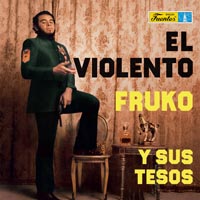
|
FRUKO Y SUS TESOS
EL VIOLENTO (Vampisoul VAMPI 287)
Quite distinct from the New York variety, Colombian salsa dura (hard salsa) is one of the delights of the evolution of popular music in the last half century. Fruko, the bassist and arranger, sets up a steamy groove for his highly accomplished singers to deliver the goods. The original singer Piper Díaz has moved on to the Latin Brothers, but has been replaced by the even-more legendary Joe Arroyo and also Wilson "Saoko" Manyoma. Sometimes bombastic, at other times laid back, there is never a slack moment for Julio "Fruko" Estrada Rincón’s band, this time out billed as Los Tesos. It's a Spanish word and in Colombia means experts. This early 70s Discos Fuentes album is obscure because it did not have a smash hit on it, but nevertheless it's fantastic. Lush horns straddle pulsating rhythms, driven by bongos and congas, played by the Villegas brothers (Jesús on the bongos and Fernando on congas), and an irresistible piano played by Hernán Gutiérrez. The timbales (Rafa Benítez, presumably not the football manager) and cuatro take over the solos in the second track, which is also the title cut, "the Violent one." In this context it just means a dance floor slammer, calling out to their compatriots in Nueva York that we have hard-ass music down here also. The bright trumpets have a nice counterpoint in the twin trombones. Obviously the brash bronx horns of Willie Colón (not the aftershave) were a major influence, but there is something really lyrical in the way Fruko's horns respond to the vocalists. And then the pride of Barranquilla works his magic on the keyboard. It's a tight set, which obviously could expand to a whole night in performance. In addition to straight-forward salsa, there are Puerto Rican rhythms like bomba, also a "Mozambique," and a new genre called "Mercy" which blends pop, soul and cumbia! It's heard on "Nadando (Swimming)" sung by Joe Arroyo. "Salsa na' ma'": Nothing more, nor less, than salsa, is the opener of side B and it introduces the band as they give it their all. It's so loud and hot that the keyboard has to go electric. |
